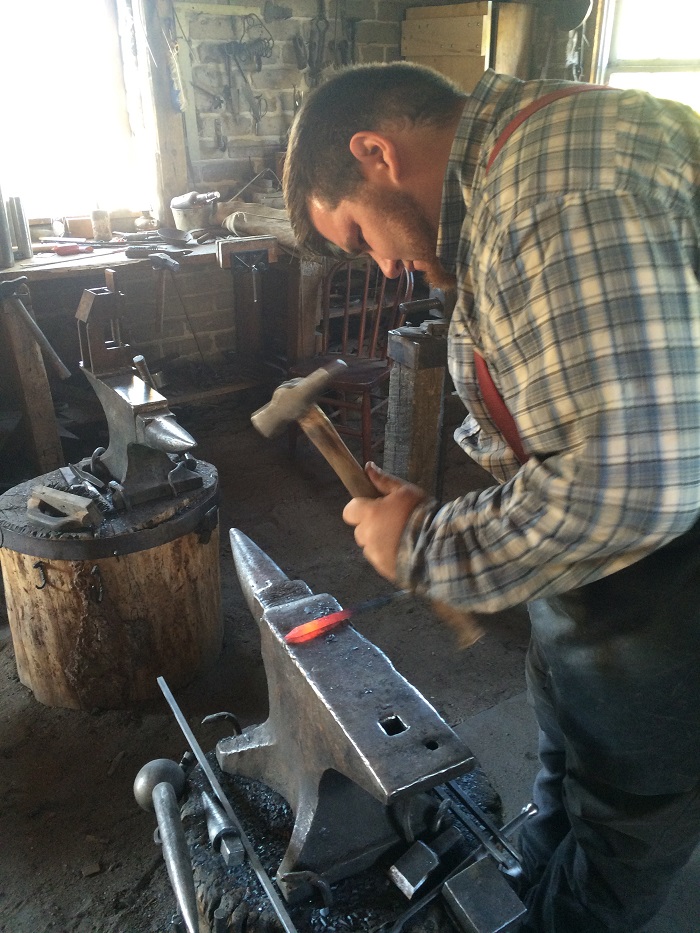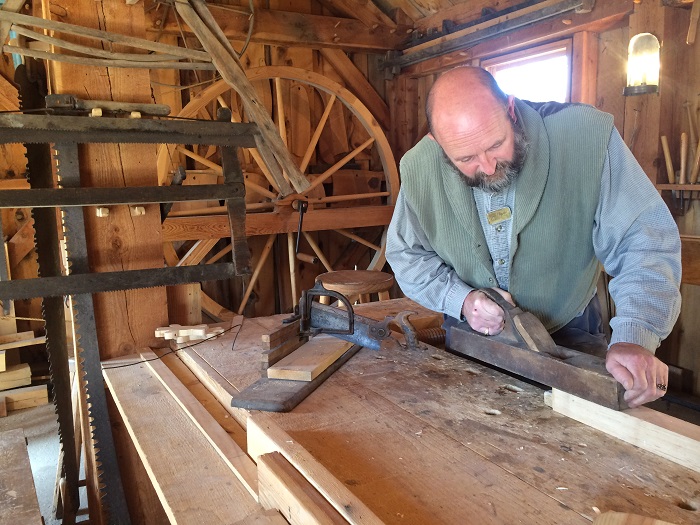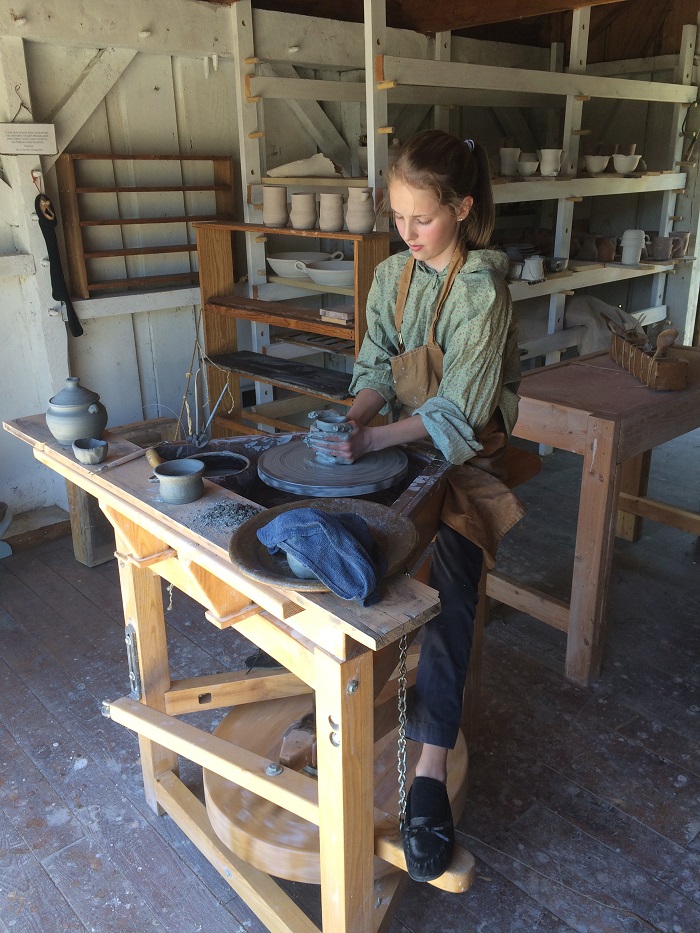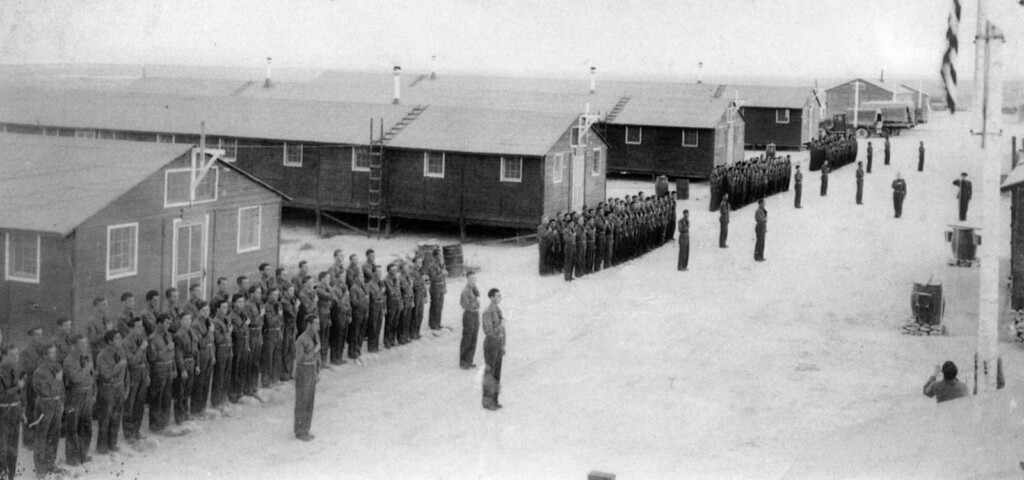
In a society where technology is capable of out-dating itself within a couple of months, it is too easy to forget that the foundation of today’s advancements were forged in the shops of tradesmen. American colonists established communities with a strong sense of self-sufficiency. If you needed something, you made it or you hired someone to make it for you.
Dozens of trades were once a vital component to early American life, as they crafted the tools and products needed for survival. Wheelwrights, coopers, chandlers, fullers, cat whippers, and cobblers were all trades that, at one point in history, served an essential role in American mercantilism. The blacksmith was so important a figure, that it was unlikely a town could have survived without one.
American pioneers traveled west with only what they could justify transporting across the plains. Kitchen tables and chairs were necessarily left behind. A sturdy dining set does lend itself to a comfortable home, so as new land was settled, a demand for crafted goods arose. Local tradesmen became a vital component to the survival of the community and, subsequently, to the economic growth of the nation.
Over time, the technological advancements made during the Industrial Revolution dictated the replacement of artisans by machinery and the assembly line. Many historic trades are now lost due to industrialism, defunct and forgotten. A small number of tradesmen do still exist, though, and some of them live and work right here in Utah.

Nestled in the foothills east of Salt Lake City, artisans can be found working their trades. Less than six miles from the city’s center, one can find an active blacksmith shop, pottery, cabinet shop, leather shop, print shop, and tinsmith shop (the only operating historic tin shop in the western United States), all working in methods consistent with those of Colonial America.
Brian Westover heads the Historic Trades program at This Is the Place Heritage Park. He was first introduced to the trades in 1998 at a blacksmithing demonstration during a boy scout camp. He went home and tried his hand at forging on his gas stove without success. He found a local smithy, enrolled in classes, and in 2005, was hired by Heritage Park as a full-time blacksmith. Since then, Westover has earned a degree in history, rounding out his hands-on experience with academic research.
Westover is deeply passionate about his work, and he understands the influence he has in being a part of passing on the knowledge of our history to the children of our future.
On October 17, 2017, Utah Stories writer, Alyssa Bray, interviewed Brian Westover about his efforts in learning about, and keeping alive, the craft, skill, and methods of historic tradesmen. Here is the interview in its entirety.
AB- “How did you come into this line of work?”
BW- “I was first exposed to historic trades in 1998 through a blacksmithing demo that I saw at a Boy Scout camp I was attending as a Scout leader. It just kind of grabbed me. I went home and tried to do some forging in my kitchen at the gas stove, without much success. I learned about a local gentlemen who taught classes so I went to him and pursued it as a hobby.”
“In 2005, I was hired by This Is The Place Heritage Park as a full time blacksmith and I’ve never looked back. In the years since then, I have gone back to school and earned a degree in history, so I have been able to round out my hands on experience with academic research.”
AB- “How would you describe the Historic Trades program at This Is The Place Heritage Park?”
BW- “In the Historic Trades program at the park we demonstrate for the public in a variety of trades shops. Besides the blacksmith, we have a leather shop, a pottery, a tinsmith, a cabinet shop, and a printing shop. We are able to outfit tinkers shops with both original and reproduction tools and equipment and create tangible objects using historic methods wherever possible.”
AB- “What is unique to the experience a guest has at This Is The Place?”
BW- “The guest experience at This Is The Place is as unique as the settlement of Utah was. Historically, most settlements in the US were established because a natural resource of some kind existed in a given area, such as water, good farmland, a shipping port, coal or other minerals, timber, etc.”
“The initial settlers were often pioneering homesteaders and farmers who would begin transforming the land and enough of them in a given area would soon bring out commerce, such as stores, and to serve the stores, freight lines were established. The longer a place is settled, the larger its population, the more urban and industrial it becomes.”
“Utah’s settlement is unique in that an entire community relocated from a distance of more than 1,000 miles. That community included famers, merchants, skilled tradesmen, civic leaders, and others. They built up a very urban environment from the beginning, constructing shops and factories. Brigham Young had industrial machines and equipment brought to the valley, as well as, sending missionaries overseas with instructions to focus on skilled tradespeople in order to build up the Kingdom of God as quickly as possible.”
“The 1850 census, taken only three years after they arrived, is loaded with a large variety of professions listed, from engineers to machinists to jewelers to “a teacher of French”. Most census records taken in a settlement only three years old would be farmers almost exclusively. To have such a small settlement with such a large variety of trades offering is unique to This Is The Place, and represents the settlement of Utah very well.”
AB- “What value do you believe having access to working his stork tradesmen provides to today’s public?”
BW- “The public benefits by having a place where they can observe these trades and their methodology being preserved and carried on by skilled workers, and gain a better appreciation for the past.”
“Ours is a very tangible world, and objects can tell stories. We are, however, becoming and increasingly intangible species. How many people do you know who spend their working hours in a place so ethereal that it’s actually called “cyberspace?”
“Many people today never give a moments thought to where the “things” in their life come from. Every object that you sleep on, shower in, brush your teeth with, cook in, eat off of, put on your body, get into and drive, work on, turn the pages of, write with, and pee in had to be made somewhere, by somebody. Even things made by machines had to be designed, financed, produced, inspected, shipped and sold by a human in the chain somewhere. When you ask a young person where his sunglasses came from he will likely say “WalMart” or “China”, but ask him who made them and you will likely be entering into territory he has never considered.”
“I believe that to be human is to make things. It is after all one of the things that separates man from his progenitors. Our guests can come to the park, see something made by hand from raw material, and I HOPE, be inspired to pick up a knife or a trowel or a needle and make something. It is something to far few people do anymore.”
AB- “How common are active workshops that are devoted to using historically accurate methods?”
BW- “There are a surprising number of Living History museums like our out there. Some are small, only one historic home or shop. Some are measured in acres and host scores of historic buildings. But some offerings are more common than others, for example, nearly every historic village has a blacksmith (as they should, no one else can do their job or work their trade without him), but only one that I am aware of, Colonial Williamsburg, has a silversmith. The tinsmith at This Is The Place is the only operating historic tin shop in the western United States.”
AB- “Where could one go to learn a hands on trade?”
BW- “As with anything else, the internet (that wicked intangible thing) is a good place to start. There are lots of instructional videos online for some trades such as blacksmithing and wood working. Others are tougher, for example there is very little on tinsmithing online. There are some master craftsmen who take apprentices or teach classes, and some colleges offer programs in historic trades, such as the Traditional Building Skills Institute at Snow College. Many museum villages like This Is The Place also offer apprenticeships and volunteer opportunities.”
AB- “Where do you think America would be today without the skills of the early tradesman?”
BW- “America would be toast without the skilled craftsmen in our past. Someone had to build the homes at Plymouth colony, forge the axes that cut open bales of tea in Boston Harbour, and make the pens, paper and ink used to create our founding documents.”
“The trades guilds in colonial America played a large role in the revolution, in great part because they were chafing under the English laws that prohibited American craftsmen from actually making anything. By law raw materials were extracted here, sent to England to be made into useful objects (and taxed) then those goods were sent to the colonies. Craftsmen and women here could only repair items, not make new ones.”
“Even more recently during World War II, it was America’s industrial capacity in large measure that helped the allies win the war. In the decades since, we have become a nation where young people are discouraged from pursuing manual trades, and “blue collar” is looked down on. They are all told they must go to college and study computers or some such. As a result we have a situation now where the average welder in the US is in his sixties, machinists are becoming rare and good sheet metal fabricators can make more than some doctors because of the scarcity of tradespeople.”
“We used to be a country that BUILT things. Now we build artificial cities in Warcraft. Do you want a young person to have a satisfying, lucrative career? Encourage him or her to look into manual trades. His children will thank you.”
General Admission tickets to This Is the Place Heritage Park allow access to the blacksmith shop, tinsmith, cabinet shop, and pottery shop during peak season. Access is limited during Christkindlmarkt, Candlelight Christmas, and winter months.
Christkindlmarkt
November 29 and 30; and December 1 and 2, 2017
11am–8pm
Free Admission
www.christkindlmarkt-slc.com
Candlelight Christmas
December 8–23, 2017
5–9pm,
Closed Sunday
$5 per person, two and under free
www.thisistheplace.org






